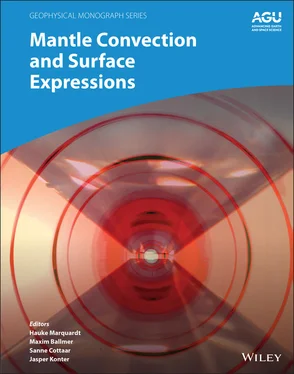Ross MaguireDepartment of Geology University of Maryland College Park, MD, USA
Ananya MallikDepartment of Geosciences University of Arizona Tucson, AZ, USA
Lowell MiyagiGeology and Geophysics University of Utah Salt Lake City, UT, USA
Pritwiraj MoulikDepartment of Geology University of Maryland College Park, MD, USA
Fabrizio NestolaDepartment of Geosciences University of Padova Padua, Italy
Andy NowackiSchool of Earth and Environment University of Leeds Leeds, UK
Sebastiano PadovanDeutsches Zentrum für Luft‐ und Raumfahrt Institute of Planetary Research Berlin, Germany; and WGS, Flight Dynamics EUMETSAT Darmstadt, Germany
Cody RandelLamont‐Doherty Earth Observatory Columbia University New York, NY, USA
Jeroen RitsemaDepartment of Earth and Environmental Sciences University of Michigan Ann Arbor, MI, USA
Dana L. RoyerDepartment of Earth and Environmental Sciences Wesleyan University Middletown, CT, USA
Maxwell L. RudolphDepartment of Earth and Planetary Sciences University of California, Davis Davis, CA, USA
Bernhard S. A. SchuberthDepartment of Earth and Environmental Sciences Ludwig‐Maximilians‐Universität München Munich, Germany
Evan M. SmithGemological Institute of America New York, NY, USA
Bernhard SteinbergerHelmholtz Centre Potsdam GFZ German Research Centre for Geosciences Potsdam, Germany; and Centre for Earth Evolution and Dynamics University of Oslo Oslo, Norway
Simon StephensonDepartment of Earth Sciences University of Oxford Oxford, UK
Henrik H. SvensenCentre for Earth Evolution and Dynamics University of Oslo Oslo, Norway
Christine ThomasInstitut für Geophysik Westfälische Wilhelms-Universität Münster, Germany
Trond H. TorsvikCentre for Earth Evolution and Dynamics University of Oslo Oslo, Norway; and School of Geosciences University of Witwatersrand Johannesburg, South Africa
Nicola TosiDeutsches Zentrum für Luft‐ und Raumfahrt Institute of Planetary Research Berlin, Germany
Dapeng ZhaoDepartment of Geophysics Tohoku University Sendai, Japan
Convection in Earth’s mantle is linked to plate tectonic processes and controls the fluxes of heat and material between deep mantle reservoirs, the surface, and the atmosphere over billions of years. A better understanding of these mantle material cycles and their impact on the long‐term evolution of our planet, as well as their potential role on other planetary bodies, requires integrated approaches that involve all disciplines studying the solid Earth.
Over the past decades, the rise in geophysical data has provided increasingly sharp images of the deep mantle, including direct images of sinking slabs and rising plumes. Increasingly accurate and novel types of geochemical data of hotspot lavas provide a detailed account of the spectrum and origin of mantle heterogeneity. Models of mantle convection make predictions on the distribution of this heterogeneity through time, and on the evolution of our planet from accretion to the present‐day. In turn, mineral physics provides increasingly realistic material properties needed to interpret the geophysical observables and constrain geodynamic models. This profound progress in the deep Earth Sciences has even advanced neighboring fields such as Planetary Sciences, Cosmochemistry, and Astrobiology, for example by providing insight into the conditions for habitability on the timescales of biological evolution, and thus, for the sustainability of higher life.
This AGU book unifies researchers with an expertise in different solid Earth disciplines, including observational geophysics, numerical modelling, geochemistry and mineral physics, to outline current concepts on dynamic processes occurring in the mantle and associated material cycles. Since each sub‐discipline is restricted by fundamental uncertainties, true progress is increasingly made at the intersection between different sub‐disciplines. The present book is hence devoted to synergetic multi‐disciplinary work, motivated by the vision of a holistic picture of the deep Earth.
Despite the common call for trans‐disciplinary research, only limited work has been done that truly and quantitatively integrates different approaches. Sometimes, just the lack of a common language, with different jargon across discipline boundaries, prevents any directed and sustainable progress. It is our hope that this AGU book can help to bridge the gaps between different Earth Science communities, resolve some semantic issues, and foster future collaborations. We attempted to ensure that chapters are written in a style accessible for researchers from all sub‐disciplines. It is up to the reader to decide if we succeeded.
This book does not aim to provide a comprehensive overview of all relevant research strands. Instead, we aim to cover a wide range of relevant topics and emphasize the interdisciplinary connection between them. As the overarching idea of the book is to bridge between the disciplines, the subsections of the book are not sorted by discipline, but instead by guiding research questions.
The first part of the book summarizes the current state of the mantle, its properties and dynamic evolution. This is followed by part two, which discusses the transport of heat and material through the mantle, as constrained by geophysical observations and geodynamic model predictions. The final part of the book focuses on the surface expressions of mantle dynamics and its control on planetary evolution and habitability.
Part I: State of the Mantle: Properties and Dynamic Evolution
The viscosity of the mantle governs large‐scale material flow within our planet and ultimately dictates the interaction between Earth's deep interior and surface geology. The first chapter of this book, contributed by Maxwell Rudolph et al., focuses on the viscosity profile of the mid‐ and lower mantle and examines its connection to mantle dynamics. Based on analysis of the geoid and seismic tomographic models, the authors favor the presence of a low‐viscosity channel in the mid‐mantle.
Mantle dynamic processes and relevant properties, including mantle viscosity, are governed by the physical behavior of mantle minerals and rocks. Lowell Miyagireviews the progress made in the experimental study of the plastic behavior of lower mantle materials at high pressures and temperatures. While the overwhelming amount of past experiments on lower‐mantle deformation has been performed on mono‐mineralic samples, he emphasizes the importance of understanding the effective rheology of rocks, which may behave dramatically different than the sum of their parts as a result of strain‐partitioning between the minerals.
The interpretation of seismic observations always critically relies on our knowledge about the elastic properties of Earth's mantle materials at the conditions expected at depth. This information is largely derived from high‐pressure/‐temperature experiments as well as computations. Johannes Buchenreviews the current state of high‐pressure/‐temperature elasticity measurements and outlines future directions. Exemplarily, he discusses the possible effect of the iron spin transition in ferropericlase, and evaluates the potential to resolve compositional variations in the mantle from seismic observations.
Geophysical observations, and their interpretation, can only provide a snapshot of the current state of Earth’s mantle, but do not directly constrain the causative history of mantle‐dynamic processes. Bernhard Schuberth and Tobias Bigalkereview approaches to quantitatively link predictions from dynamic mantle evolution models to present‐day seismological observations. After providing a general overview of past works, they focus on the importance of better constraining anelastic effects and their uncertainties to interpret seismic observations, as may be constrained by future mineral physics work.
Читать дальше












